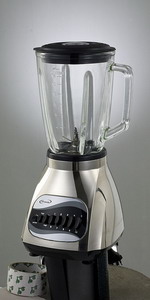 The very first smoothie was invented not surprisingly shortly after the invention of the blender in the 1930s. The Hamilton Beach, Waring, and Vitamix were all created during this time. Originally designed for making malted milkshakes, creative folks began to find all kinds of uses for the new kitchen
tool. Health food stores on the West Coast began selling blended-up concoctions of fruit and vegetables with yogurt or ice as a healthy tonic and easy way to get your daily need for vegetables and fruit down the hatch. In a blended liquefied form it was easy to enhance the flavor with healthier sweeteners or sweet fruits.
The very first smoothie was invented not surprisingly shortly after the invention of the blender in the 1930s. The Hamilton Beach, Waring, and Vitamix were all created during this time. Originally designed for making malted milkshakes, creative folks began to find all kinds of uses for the new kitchen
tool. Health food stores on the West Coast began selling blended-up concoctions of fruit and vegetables with yogurt or ice as a healthy tonic and easy way to get your daily need for vegetables and fruit down the hatch. In a blended liquefied form it was easy to enhance the flavor with healthier sweeteners or sweet fruits.
 Fast forward to today, and the same companies dominate the market, even though ownership has changed hands many times. The blender of today is used for all sorts of uses besides just smoothies, but I think smoothies are still the best product that pours from a blender. Admittedly I use my Vitamix for many
other things, like making nut butter cheese, soup stock, guacamole, keto waffle batter, dressings, and even herbal blends. It is my most used appliance on my kitchen counter. But every morning it is conscripted to make our morning super smoothie.
Fast forward to today, and the same companies dominate the market, even though ownership has changed hands many times. The blender of today is used for all sorts of uses besides just smoothies, but I think smoothies are still the best product that pours from a blender. Admittedly I use my Vitamix for many
other things, like making nut butter cheese, soup stock, guacamole, keto waffle batter, dressings, and even herbal blends. It is my most used appliance on my kitchen counter. But every morning it is conscripted to make our morning super smoothie.
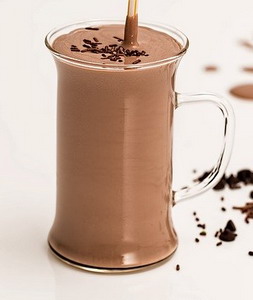 My super smoothie does not much seem like what you would think of as a smoothie. That is because the recipe for this smoothie grew out of my getting tired of taking so many pill-type supplements over the years. Initially, I started just throwing some of my less bitter supplements into a blended up
breakfast drink. The Vitamix would powder up the tablets and shatter the capsules. This would work somewhat, but a significant portion of the pills would end up as a gritty lump in the bottom of the container. That is when I started looking into buying my supplements in bulk as a pure powder without all the binding agents necessary to form a tablet or as filler in capsules. This opened up a whole new world as supplement taking could be made simple by just drinking a
morning smoothie.
My super smoothie does not much seem like what you would think of as a smoothie. That is because the recipe for this smoothie grew out of my getting tired of taking so many pill-type supplements over the years. Initially, I started just throwing some of my less bitter supplements into a blended up
breakfast drink. The Vitamix would powder up the tablets and shatter the capsules. This would work somewhat, but a significant portion of the pills would end up as a gritty lump in the bottom of the container. That is when I started looking into buying my supplements in bulk as a pure powder without all the binding agents necessary to form a tablet or as filler in capsules. This opened up a whole new world as supplement taking could be made simple by just drinking a
morning smoothie.
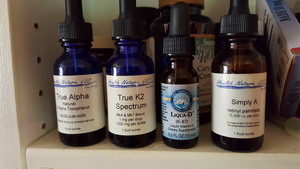 A couple of hiccups along the way showed up with certain nutrients that were needed in such tiny quantities that I had to use a micro-gram scale to measure them – vitamins like vitamin A, D, and K2 or trace minerals. Other vitamins only really exist in a liquid oil form like vitamin E. The other major
hiccup was just how nasty some supplements taste, like some of the B vitamins or krill oil. Although I did actually buy a micro-gram scale and make up a powder mix of the “tiny” supplements mixed into my Support Amino acid blend, initially I just used high strength liquid vitamins like the liquid vitamin A and D3 I carry in the office and used a dropper to add them to my morning smoothie. (I don't carry liquid E or K2, so I had to find those on the internet.)
For the nasty B vitamins and krill oil, I simply resigned to taking them in pill form to avoid the taste.
A couple of hiccups along the way showed up with certain nutrients that were needed in such tiny quantities that I had to use a micro-gram scale to measure them – vitamins like vitamin A, D, and K2 or trace minerals. Other vitamins only really exist in a liquid oil form like vitamin E. The other major
hiccup was just how nasty some supplements taste, like some of the B vitamins or krill oil. Although I did actually buy a micro-gram scale and make up a powder mix of the “tiny” supplements mixed into my Support Amino acid blend, initially I just used high strength liquid vitamins like the liquid vitamin A and D3 I carry in the office and used a dropper to add them to my morning smoothie. (I don't carry liquid E or K2, so I had to find those on the internet.)
For the nasty B vitamins and krill oil, I simply resigned to taking them in pill form to avoid the taste.
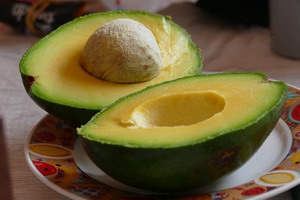 What to use for the base liquid for the smoothie was the next question. I started off using almond milk since Ellen is sensitive to dairy. I have tried most of the milk alternatives, and find that personally, I like the flavor of canned coconut milk watered down 3 to 1 with filtered water. For a long
time, I made a milk of my own by blending ripe avocado with water, which works out well and carries the nutrient value found in the avocado. Generally, I will add a tablespoon of raw cacao powder and either stevia powder or liquid for sweetener. Cacao powder is really a tropical superfood with 10,000 times the antioxidants of currently touted superfoods like kale.
What to use for the base liquid for the smoothie was the next question. I started off using almond milk since Ellen is sensitive to dairy. I have tried most of the milk alternatives, and find that personally, I like the flavor of canned coconut milk watered down 3 to 1 with filtered water. For a long
time, I made a milk of my own by blending ripe avocado with water, which works out well and carries the nutrient value found in the avocado. Generally, I will add a tablespoon of raw cacao powder and either stevia powder or liquid for sweetener. Cacao powder is really a tropical superfood with 10,000 times the antioxidants of currently touted superfoods like kale.
 The sweetener is critical for the final taste of the smoothie as well as for keeping it healthy. The biggest problem with most blender smoothies is that they are full of sugar. Sugar and seed oils are the basis for most of the degenerative diseases of mankind, so we really don't want either of these
ending up in our smoothie. I am sorry, but the sugar in fruit is not any better, so adding fruit to a smoothie is a really bad idea other than a low-sugar fruit like raspberries. The whole idea of the health store smoothie revolved around selling the sweet goodness of blended whole fruit. While it is certainly better than fruit juice since the fiber from the pulp is blended in, the high sugar levels are a problem for most people. The fructose in fruit is the main cause of
fatty liver disease in people these days.
The sweetener is critical for the final taste of the smoothie as well as for keeping it healthy. The biggest problem with most blender smoothies is that they are full of sugar. Sugar and seed oils are the basis for most of the degenerative diseases of mankind, so we really don't want either of these
ending up in our smoothie. I am sorry, but the sugar in fruit is not any better, so adding fruit to a smoothie is a really bad idea other than a low-sugar fruit like raspberries. The whole idea of the health store smoothie revolved around selling the sweet goodness of blended whole fruit. While it is certainly better than fruit juice since the fiber from the pulp is blended in, the high sugar levels are a problem for most people. The fructose in fruit is the main cause of
fatty liver disease in people these days.
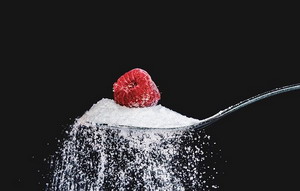 So what sweeteners are okay? The two best are stevia and monk fruit (lo han). The next best is the sugar alcohol erythritol and the rare sugar allulose, as they don't cause stomach distress and mostly pass out from the body in our urine. A new player that sounds like it will be excellent is
tagatose, however, I have not been able to find a source for it other than overseas costing around $60 a pound. Other acceptable sweeteners are glycerin and oligosaccharides, though they are not as available as stevia. All the artificial sweeteners like Nutrasweet, Equal, Splenda, AceK, saccharin, are all evil as they destroy the healthy gut microbiome. Natural sweeteners like honey, maple syrup, agave, date sugar, organic raw, and all the rest are all triggers for systemic
inflammation and insulin resistance, so they are out. Personally, I mostly use stevia in my smoothies. In baking, I use my Dr Dave Sugar which is a blend of stevia and erythritol at about double the sweetness of regular cane sugar.
So what sweeteners are okay? The two best are stevia and monk fruit (lo han). The next best is the sugar alcohol erythritol and the rare sugar allulose, as they don't cause stomach distress and mostly pass out from the body in our urine. A new player that sounds like it will be excellent is
tagatose, however, I have not been able to find a source for it other than overseas costing around $60 a pound. Other acceptable sweeteners are glycerin and oligosaccharides, though they are not as available as stevia. All the artificial sweeteners like Nutrasweet, Equal, Splenda, AceK, saccharin, are all evil as they destroy the healthy gut microbiome. Natural sweeteners like honey, maple syrup, agave, date sugar, organic raw, and all the rest are all triggers for systemic
inflammation and insulin resistance, so they are out. Personally, I mostly use stevia in my smoothies. In baking, I use my Dr Dave Sugar which is a blend of stevia and erythritol at about double the sweetness of regular cane sugar.
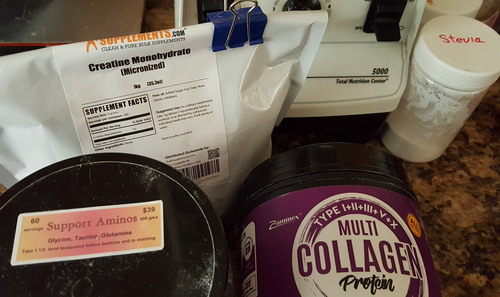 Okay, so we have the “milk” base and the sweetener covered. What are the nutrients I put in my smoothie? I put in a tablespoon of my Support Aminos, which are glycine (which forms collagen and protects liver and heart), glutamine (rebuilds gut lining), and taurine (nervous system, electrolytes,
immune health, mineral balance, digestion). I add in a teaspoon of sunflower lecithin for the choline for my brain. I also add a big scoop of creatine for strength and muscle mass, collagen for ligaments, bone, and skin, and a scoop of colostrum for repairing leaky gut. I also add a tablespoon of my Gut Repair for all the soluble fibers to feed the good guy bacteria as well as more gut-healing herbs. Interestingly, the stevia I sweeten the smoothie with also has
health benefits. Stevia helps dissolve the biofilms the bad guy bacteria hide under. I add a teaspoon of my Balanced salt for the trace minerals and electrolytes to the smoothie as well as all the liquid vitamins, the A, D, E, and K. Last of all I squirt in a couple of tablespoons of C8 caprylic acid to support the ketone formation pathways for ketone energy for my heart and brain, and a nice squirt of real vanilla for added flavor. I blend all this on medium for a few
seconds and I have a lovely chocolate milkshake fit for a king.
Okay, so we have the “milk” base and the sweetener covered. What are the nutrients I put in my smoothie? I put in a tablespoon of my Support Aminos, which are glycine (which forms collagen and protects liver and heart), glutamine (rebuilds gut lining), and taurine (nervous system, electrolytes,
immune health, mineral balance, digestion). I add in a teaspoon of sunflower lecithin for the choline for my brain. I also add a big scoop of creatine for strength and muscle mass, collagen for ligaments, bone, and skin, and a scoop of colostrum for repairing leaky gut. I also add a tablespoon of my Gut Repair for all the soluble fibers to feed the good guy bacteria as well as more gut-healing herbs. Interestingly, the stevia I sweeten the smoothie with also has
health benefits. Stevia helps dissolve the biofilms the bad guy bacteria hide under. I add a teaspoon of my Balanced salt for the trace minerals and electrolytes to the smoothie as well as all the liquid vitamins, the A, D, E, and K. Last of all I squirt in a couple of tablespoons of C8 caprylic acid to support the ketone formation pathways for ketone energy for my heart and brain, and a nice squirt of real vanilla for added flavor. I blend all this on medium for a few
seconds and I have a lovely chocolate milkshake fit for a king.
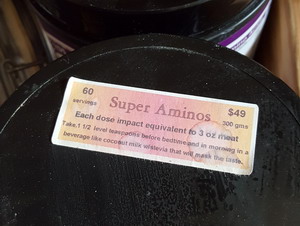 As you can see, I am really amping up on a boatload full of nutrients that cover a lot of the health systems in my body. This is a great way to start the day. Some days I might add some extra herbs if I feel the need. Sometimes I will also put in a couple of ounces of my Super Amino acid blend which
provides a perfect balance of amino acids for rebuilding and repairing the tissues of my body. Super Aminos taste bitter, so I have to feel motivated by need to put them in my smoothie. What nutrients do I still have to take in pill form? My curcumin stains everything terribly when I take it out of the capsule, so it stays in the capsule. B vitamins, krill oil, and CBD stay in the capsules because I don't like the taste. My magnesium and calcium I tend to take
in tablet form because the amount I need would fall to the bottom of the smoothie as a gritty lump, so I still take them alone. Otherwise, most of what I need is in my super smoothie.
As you can see, I am really amping up on a boatload full of nutrients that cover a lot of the health systems in my body. This is a great way to start the day. Some days I might add some extra herbs if I feel the need. Sometimes I will also put in a couple of ounces of my Super Amino acid blend which
provides a perfect balance of amino acids for rebuilding and repairing the tissues of my body. Super Aminos taste bitter, so I have to feel motivated by need to put them in my smoothie. What nutrients do I still have to take in pill form? My curcumin stains everything terribly when I take it out of the capsule, so it stays in the capsule. B vitamins, krill oil, and CBD stay in the capsules because I don't like the taste. My magnesium and calcium I tend to take
in tablet form because the amount I need would fall to the bottom of the smoothie as a gritty lump, so I still take them alone. Otherwise, most of what I need is in my super smoothie.
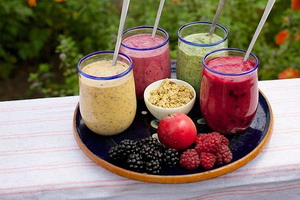 Could you make a super smoothie without a “milk” and use blended veggies and low-sugar fruit? Of course, you could. In that case you would leave out the cacao powder and vanilla. Beyond that, it should work out just fine. I am just not a big fan of green smoothies. The high
levels of oxalates and lectins are problematic for me. Be careful of spinach smoothies. The oxalate levels are so high in spinach that many people have actually died from consuming them. Most other greens are fine for most people.
Could you make a super smoothie without a “milk” and use blended veggies and low-sugar fruit? Of course, you could. In that case you would leave out the cacao powder and vanilla. Beyond that, it should work out just fine. I am just not a big fan of green smoothies. The high
levels of oxalates and lectins are problematic for me. Be careful of spinach smoothies. The oxalate levels are so high in spinach that many people have actually died from consuming them. Most other greens are fine for most people.
 One last tidbit is that I rarely actually drink this for breakfast. I put it in a thermos and drink half at my 11:30 break and the other half at my 1:30 break at work. By not consuming any food until late morning, my system is able to spend more time detoxifying and less time processing food. I eat
dinner at 4 pm and nothing after that (unless I am baking some special treat!)
One last tidbit is that I rarely actually drink this for breakfast. I put it in a thermos and drink half at my 11:30 break and the other half at my 1:30 break at work. By not consuming any food until late morning, my system is able to spend more time detoxifying and less time processing food. I eat
dinner at 4 pm and nothing after that (unless I am baking some special treat!)
Take care,
David
We have received the second batch of 20  copies of my book The Balanced Life. For those of you that signed up for the book last year, we have set
your copies aside. They are available in the office for $17.99, and they are also available on Amazon.com
copies of my book The Balanced Life. For those of you that signed up for the book last year, we have set
your copies aside. They are available in the office for $17.99, and they are also available on Amazon.com
Ellen update:
 Ellen has been officially discharged by her home health team assigned her by Mercy Health. She is excited because she is fit enough to go back to work. Her clients will be happy to hear that. Using muscle testing and Heartflow philosophy, she helps folks get back on track with growing towards
fulfilling their heart's desires. We are so easily mislead by all the flash and dazzle of the outside world that often it takes someone who is on the outside to help us see ourselves, help us feel what our heart is really wanting. That is Ellen's job. Pretty cool, huh!
Ellen has been officially discharged by her home health team assigned her by Mercy Health. She is excited because she is fit enough to go back to work. Her clients will be happy to hear that. Using muscle testing and Heartflow philosophy, she helps folks get back on track with growing towards
fulfilling their heart's desires. We are so easily mislead by all the flash and dazzle of the outside world that often it takes someone who is on the outside to help us see ourselves, help us feel what our heart is really wanting. That is Ellen's job. Pretty cool, huh!

